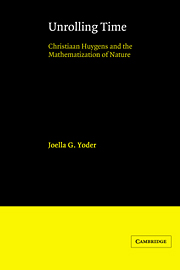3 - Accelerated motion: centrifugal force
Published online by Cambridge University Press: 07 December 2009
Summary
On October 21, 1659, twelve years after Mersenne had described his efforts to determine the constant of gravitational acceleration and the problems that he encountered, Christiaan Huygens repeated Mersenne's experiment. He accepted Mersenne's length of 3 feet for the seconds-pendulum but added an extra inch, thus compensating for the fact that his Rhenish foot was shorter than the Parisian Royal foot used by Mersenne, and found that a lead ball fell 3½ feet during the ½-second swing of the pendulum against the wall. Thus, by Galileo's times-squared law, it would fall 14 feet in 1 second, a value significantly different from Mersenne's 12 feet, even when the latter was converted to Rhenish feet (12 feet 5 inches). Since Huygens also knew of Riccioli's value of 15 feet in 1 second, the discrepancy between the experimental values determined by himself, Riccioli, and Mersenne was readily noticeable. It is not surprising, therefore, that Huygens sought a different means of determining the constant of gravitational acceleration.
That same October day on which he tried Mersenne's experiment, Huygens undertook a study of centrifugal force, recording a list of propositions that a few weeks later he would develop into a more complete treatise, the work now called De Vi Centrifuga. He was obviously still hunting for an accurate value for the constant of gravitational acceleration, for among the opening notes of the first draft is a reference to Riccioli's trials showing that gravity increases according to the odd numbers, followed by the phrases “Weight is the conatus [effort, tendency] to descend” and “concerning an accurate measure by means of the oscillations of a clock.”
- Type
- Chapter
- Information
- Unrolling TimeChristiaan Huygens and the Mathematization of Nature, pp. 16 - 43Publisher: Cambridge University PressPrint publication year: 1989



